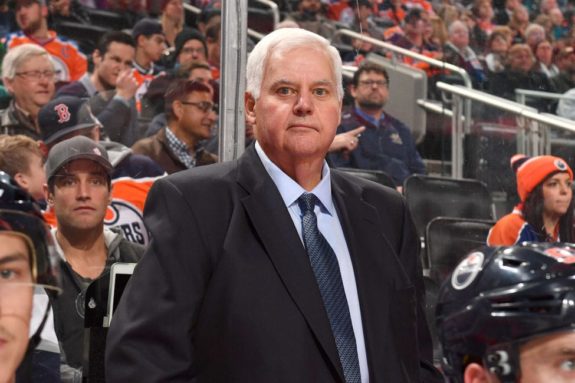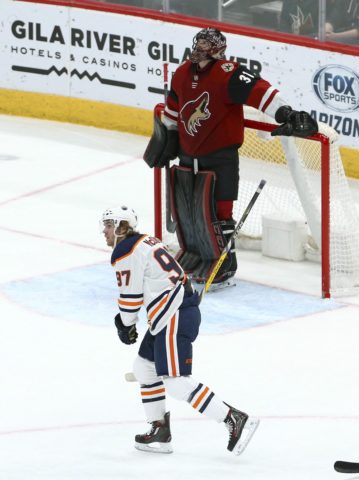![]()
The Edmonton Oilers recent six-game losing streak was mired by an inability to defend, as the team allowed a galling 29 goals during that stretch. However, as the streak was peaking, the team dumped Drake Caggiula to acquire Brandon Manning on the same day they traded for Alexander Petrovic, two defensive minded defensemen. Staying away from commentary on the quality of the acquisitions, which is available nearly everywhere (including here at The Hockey Writers and over at The Hockey News), Oilers writers, fans, and even the head coach have now started down a different path of discovery.
The Oilers Secondary Scoring is a Disaster
Of the many articles and tweets that have covered this topic over recent days, my favourite is Jason Gregor’s for OilersNation. Simply counting goals scored by forwards, Gregor notes that the Oilers top four forwards (Connor McDavid, Leon Draisaitl, Ryan Nugent-Hopkins, and Alex Chiasson) stack up well against the rest of the league, scoring (at the time of writing) the fourth most goals among ‘top-fours’ league-wide, with 75. That has them ahead of vaunted goal-scoring teams like the Maple Leafs, Jets, Sharks and Penguins.
On the flip-side, the team’s remaining forwards have scored only 24 goals, which puts them last in the league by a stunning margin. The next worst teams have 33 goals in that category while the league average is nearly double the Oilers’ output at 45. The Oilers total is even worse when you consider that it includes the recently traded Caggiula and his seven goals.
Hitchcock’s Plan to Balance the Oilers’ Lineup
Ken Hitchcock is not in control of the roster and is tasked with finding a way to win hockey games with, or in spite of, whatever group of players management provides. Since significant injuries to Oscar Klefbom and Kris Russell helped paved the way for the Oilers’ losing streak, this job has become significantly more difficult.

At practice on New Year’s Day, Hitchcock introduced new forward lines and new marching orders for lines not including Connor McDavid: don’t get scored on. Blessed as a wordsmith, Hitchcock never makes players sound bad unless he wants to, but veiled in the comments below (from NHL.com/oilers) is a recognition that none of the Oilers’ depth forwards can be relied on to score.
“We got to do a better job of limiting the chances on the back end of our lineup. Way too many in-zone scoring chances, way too many red zone scoring chances. We got to stop that if we want to win hockey games… We’re right on the edge of it. We got a lot of things that are really going well from a play standpoint but we give up way too many red zone scoring chances too deep down our lineup…”

“The idea is that if we want to build a team that plays properly the right way, then when we spread it out, we got everybody looking for offence whereas I would rather have it salted in one area and then everybody else checks. If we check, we’ll be fine because we’re scoring enough goals to win hockey games. Offence isn’t the problem. Checking is the problem… What I mean by that is our problems defensively are the way we manage the puck. When we split everybody up, now we got three lines playing risky hockey and it doesn’t work. This way, we get, hopefully, some conservative and smart play and manage the game properly. Then our big guys have to score.”
The second paragraph above was in response to a question about putting Draisaitl back onto McDavid’s line. While Todd McLellan was regularly challenged about not spreading the scoring out by separating his two best offensive centres, I don’t mind Hitchcock’s approach here for two reasons. First, he recognizes that in the long-run, the ideal team that “plays properly the right way” is one that has the offense spread out – likely meaning McDavid and Draisaitl on different lines. Second, he has very specific role definition for the remainder of the lineup, something that may have lacked under McLellan and seems to be a strength of Hitchcock.
Oilers Lines Moving Forward
We should probably wait more than one game to make any conclusions about Hitchcock’s current plan, but for one day, albeit against the lowly Arizona Coyotes, the plan worked. The Oilers top line of McDavid, Draisaitl, and new addition Zack Kassian accounted for all three Oilers’ goals (two at five-on-five and one empty net) while giving up the lone Coyotes’ goal. While the top line played to the game’s final score of 3-1, the remainder of the forward lines played the game to a 0-0 draw, just as Hitchcock asked. It is the ‘Identity Line’ strategy, spread over nearly the entire lineup.
A greater test will come over the next three games, with the Oilers visiting California to face the Kings, Ducks, and Sharks. I expect that will give us a greater indication of how long Hitchcock intends to use this strategy, or if he believes that he can spread the offensive wealth more once the team reestablishes some better neutral and defensive zone habits.
Draisaitl-McDavid-Kassian
Rieder-RNH-Chiasson
Lucic-Khaira-Puljujarvi
Spooner-Brodziak-Rattie
GambardellaNurse-Larsson
Jones-Petrovic
Gravel-Manning
Russell-BenningKoskinen-starters net
— Bob Stauffer (@Bob_Stauffer) January 5, 2019
Reports from the Oilers morning skate in Los Angeles have the team keeping Kassian on the top line while reintegrating the now-healthy Chiasson on the second line with Nugent-Hopkins. Kassian looked good in his first stint of the season with McDavid and Draisaitl, and has produced an excellent 77 scoring chances for to 58 scoring chances against when paired with Draisaitl for just under 133 minutes over his three full seasons in Edmonton. As Hitchcock has continually adjusted the lineup configuration based on performance, it will be intriguing to see if Kassian sees a continued role on the top line or in the top six. Just as important will be to follow if the bottom two or three lines can continue to give up very little against stronger teams, allowing the dominant McDavid and Draisaitl to determine the outcome of the game.